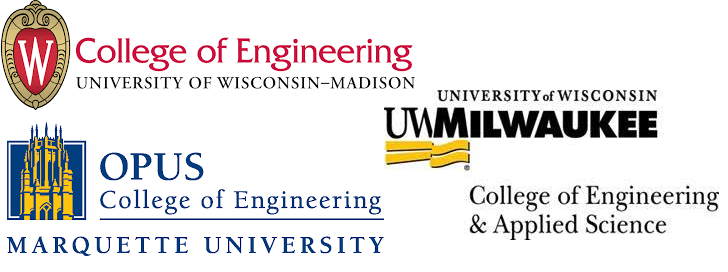This article features top engineering colleges in Wisconsin that offer master and doctoral degrees in the fields of biological engineering, chemical engineering, computer science, materials engineering, mechanical engineering, etc. Please be informed that each school receives national wide rank as the ranking compares all engineering schools in the United States. Some important ranking factors include average GRE scores, alumni surveys, current student interviews, institutional research publications, and peer college assessment. In the following list of best engineering schools in the state of Wisconsin, you can see tuition cost for both in-state and out-of-state students, acceptable rates and admissions statistics for each top ranked engineering college.

| National Ranking | Wisconsin Top Engineering Programs |
| 17 | University of Wisconsin–Madison (Madison, WI) Overall acceptance rate: 14.0% Average GRE quantitative score (master’s and Ph.D. students): 780 Tuition: In-state, full-time: $11,376 per year, Out-of-state, full-time: $25,134 per year Total graduate engineering enrollment: 1,751 Research expenditures per faculty member: $658,597 Engineering school research expenditures (2010-2011 fiscal year): $148,842,969 Faculty membership in National Academy of Engineering: 3.5% |
| 131 | Marquette University (Milwaukee, WI) Overall acceptance rate: 52.3% Average GRE quantitative score (master’s and Ph.D. students): 735 Tuition: Full-time: $945 per credit Total graduate engineering enrollment: 216 Research expenditures per faculty member: $107,806 Engineering school research expenditures (2010-2011 fiscal year): $5,713,752 Faculty membership in National Academy of Engineering: 0.0% |
| 134 | University of Wisconsin–Milwaukee (Milwaukee, WI) Overall acceptance rate: 57.1% Average GRE quantitative score (master’s and Ph.D. students): N/A Tuition: In-state, full-time: $10,944 per year, Out-of-state, full-time: $23,865 per year Total graduate engineering enrollment: 346 Research expenditures per faculty member: $104,907 Engineering school research expenditures (2010-2011 fiscal year): $8,392,600 Faculty membership in National Academy of Engineering: 0.0% |
Wisconsin Modern History
Wisconsin from the first years of its statehood opposed slavery, being one of the strongholds of abolitionism in the north of the United States. It was in Wisconsin in 1854 that the first meeting of the US Republican Party was held, uniting the opponents of slavery. The episode that went down in the history of the state as “Salvation of Joshua Glover” is widely known.
In 1852, Joshua Glover, a black slave, fled from St. Louis, Missouri , to Racine. In 1854, he was arrested by federal marshals under the US federal law on the return of fugitive slaves and placed in the Milwaukee prison.
This incident received publicity and caused outrage among the residents of the city. A mob led by Sherman Booth, a well-known Wisconsin political activist of the time, freed Glover from prison (and he later fled to Canada).
Sherman Booth was arrested by the authorities, but as a result of the proceedings, the Wisconsin Supreme Court found the federal law on the return of fugitives unconstitutional, thereby exonerating Booth. The US Supreme Court overturned the decision of the Wisconsin court, Sherman Booth was again arrested and convicted, but again appealed to the state court, which again declared the Fugitive Slave Law inconsistent with the US Constitution. The lawsuit in the Booth case dragged on until the start of the American Civil War, which finally decided the question of the illegality of slavery in the United States.
